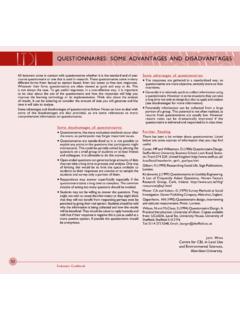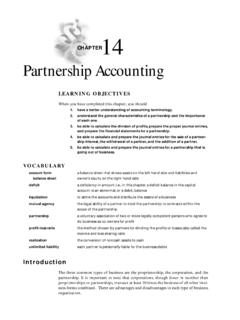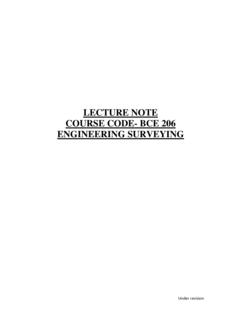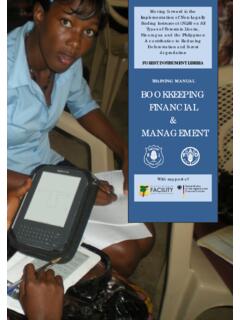Transcription of LAND RIGHTS UNDER THE INGONYAMA TRUST
1 1 land RIGHTS UNDER THE INGONYAMA TRUST February 2015 The INGONYAMA TRUST was the outcome of a deal between the National Party and the Inkatha Freedom Party during the dying days of apartheid just before the transition in 1994. The TRUST was established to manage land owned by the government of KwaZulu, and is currently responsible for managing some million hectares of land in KwaZulu-Natal. The land vests in the INGONYAMA (or king) as trustee, to be administered on behalf of members of specific communities. While the TRUST has wide powers to manage the land , the law also provides that the land RIGHTS of individuals and communities UNDER the TRUST must be respected by the TRUST . This fact sheet seeks to examine the INGONYAMA TRUST Act, which created the TRUST , to consider the nature of individual and community land RIGHTS UNDER the TRUST .
2 PROTECT YOUR RIGHTS While land RIGHTS over land administered by the INGONYAMA TRUST have strong protection, these RIGHTS are not well known. If you or anyone you know has their land RIGHTS threatened, please immediately contact AFRA at 033 345 7607 or or Michael Clark or Stha Yeni of the Centre for Law and Society at UCT, by phone at 021 650 3360 or by email at THE INGONYAMA TRUST ACT The INGONYAMA TRUST was established in 1994 to manage land owned by the government of KwaZulu immediately prior to the Act s commencement. The TRUST was established by the KwaZulu-Natal INGONYAMA TRUST Act, which was enacted by the KwaZulu Legislative Assembly and came into effect on 24 April 1994. The TRUST land vests in the INGONYAMA , King Zwelithini, as trustee on behalf of members of communities defined in the Act.
3 The Act was significantly amended in 1997 to create the KwaZulu-Natal INGONYAMA TRUST Board to administer the land in accordance with the Act. The current chairperson of the Board is former judge Jerome Ngwenya. Key provisions of the Act Section 2(2) The TRUST shall, in a manner not inconsistent with the provisions of this Act, be administered for the benefit, material welfare and social well-being of the members of the tribes and communities as contemplated in the KwaZulu Amakhosi and Iziphakanyiswa Act. Section 2(3) The INGONYAMA shall be the trustee of the TRUST which shall be administered subject to the provisions of this Act by the INGONYAMA and the board. Section 2(4) The INGONYAMA may, subject to the provisions of this Act and any other law, deal with the land referred to in section 3(1) in accordance with Zulu indigenous law or any other applicable law.
4 (Lawyers advise that may probably means must in this context) 2 Section 2(5) The INGONYAMA shall not encumber, pledge, lease, alienate or otherwise dispose of any of the said land or any interest or real right in the land , unless he has obtained the prior written consent of the traditional authority or community authority concerned. Section 2(7) Notwithstanding the provisions of this Act, any national land reform programme established and implemented in terms of any law shall apply to the land referred to in section 3(1): Provided that the implementation of any such programme on the land referred to in section 3(1) shall be undertaken after consultation with the INGONYAMA . Section 2(8) In the execution of his or her functions in terms of this section the INGONYAMA shall not infringe upon any existing RIGHTS or interests.
5 UNDERSTANDING THE ACT As seen in the map on the back page of this fact sheet, the INGONYAMA TRUST administers significant amounts of land across KwaZulu-Natal. The TRUST estimates that it administers some million hectares. Given the TRUST s wide powers and broad impact, it is important to understand the RIGHTS of people living on land administered by the TRUST . Recently, it has become clear that there are two ways in which the TRUST is threatening the RIGHTS of rural communities: by authorising mining activities and other developments on the land , which is frequently done without proper community consultation and could lead to the deprivation of use RIGHTS and access to land ; and by converting people s land RIGHTS (over land occupied and inherited by families over generations) into lease agreements.
6 These actions affect the community RIGHTS and individual RIGHTS of people living on TRUST land , and will be discussed in more detail below. COMMUNITY RIGHTS ON INGONYAMA TRUST land As stated above, the Act places a burden upon the TRUST to administer the land for the material benefit and social well-being of communities listed in the Act. This places an obligation upon the TRUST to not conclude agreements in relation to community land that would prejudice community members. This obligation is enforceable in the courts. One of the specific protections in this regard is that the written consent of local traditional leaders must be obtained before any steps are taken in regard to land RIGHTS . This does not mean that the written consent of a traditional leader is enough to establish that the TRUST is acting in the best interests of a community.
7 If the TRUST enters into an agreement about land RIGHTS that is harmful to the community, it can be challenged. The problem is that it may be difficult to prove the harmfulness of the TRUST s decisions in some circumstances. While an agreement that is clearly negative for the community can be challenged, many agreements will come with both advantages and disadvantages . As courts will generally tend to leave decision-making to the trustees discretion, it seems likely that only decisions that seriously undermine community RIGHTS will succeed. Community objections and disapproval will not necessarily be enough to legally challenge a decision of the TRUST . 3 Community consultation While the content of an agreement may be difficult to challenge, a lack of community consultation may result in possibilities for challenging an agreement on procedural grounds.
8 Section 2(4) of the Act establishes that the INGONYAMA may administer the land in accordance with Zulu customary law. Section 2(8) establishes that the INGONYAMA shall not interfere with existing RIGHTS or interests to the land . According to a study of customary land law in Msinga conducted by the Institute for Poverty, land and Agrarian Studies (PLAAS), when an outsider is seeking access to land it is not sufficient for them to merely receive the approval of an Inkosi or an Induna. The demarcation of the land must include the consultation of the Ibandla and the potential neighbours of the outsider applying for land . A similar study by the LEAP project found that the agreement of the potential neighbours is essential for an outsider to be allocated land .
9 The Ibandla must also be consulted. Customary land law clearly requires consultation with neighbours and the Ibandla. If an agreement is made to give RIGHTS to community land to an outsider without such consultation, communities may be able to challenge this agreement in a court. The Constitution upholds RIGHTS derived from customary law that are consistent with the Bill of RIGHTS in sections 39(3) and 211(3). The Promotion of Administrative Justice Act Apart from the RIGHTS UNDER the TRUST Act, affected communities may also challenge decisions the TRUST makes in regard to land UNDER the Promotion of Administrative Justice Act 3 of 2000 (PAJA). PAJA regulates administrative action (the exercise of government power or performance of a public function) to ensure that it is exercised in a just fashion.
10 PAJA defines administrative action as including action by non-state bodies exercising a government power or performing a public function in terms of law. There is no doubt that the INGONYAMA TRUST is subject to the PAJA and administrative law. The PAJA provides for fair administrative action in two sections. Both require that the people affected by the decision participate in the process of making it. Section 3 sets out the requirements for fair administrative action when a person s RIGHTS or expectations of fairness are involved. Unless there are clear reasons for not doing so, a person whose RIGHTS would be affected is entitled to be informed about the proposed action, to request reasons for the action, and to be consulted regarding the action. Section 4 sets out the requirements for procedurally fair administrative action where a proposed administrative action affects the RIGHTS of the public in ways that cause them significant harm.




